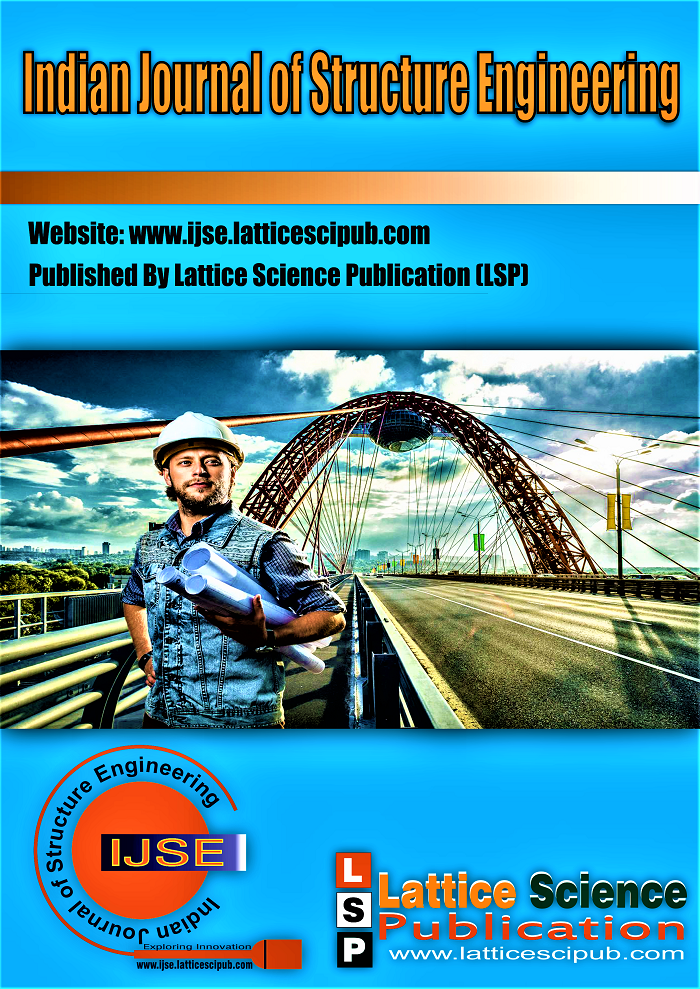Analysis of Concrete Block by Partial Replacement of Cement with Fly Ash
Main Article Content
Abstract
The objective of this research is to enhance the properties of concrete by using Fly Ash as a partial substitution of concrete. Tests carried out on cement are Initial and Final setting time and on aggregates, specific gravity and sieve analysis. The mean target strength with given compressive strength at 28 day and quality control level is calculated. Concrete blend proportions for the first tryout mix is calculated and casting of cube of 15mm size with curing for 28 days, and then test for strength using UTM/CTM machines. C-S-H gel as well as Calcium hydroxide as bi product when reacts with water. C-S-H gel has an ability to keep the ingredients together by making a proper bond whereas lime which is freely available can react with atmospheric moisture and cause efflorescence. In such cases if we use fly ash, it reacts with free lime and produces C-SH gel again and water as bi product. We have used Fly ash as a partial replacement of cement with variation of fly ash in percentage. In this study fly ash add in increment of 5%, 10%, 15%, 20%, 25%, 30% and 35% replacement of cement which has shown satisfactory results in the strength of the concrete. Fly Ash improved the workability of the concrete, decreases the bleeding, surface finish and increases the cohesiveness. Compressive strength is comparatively increased. The initial strength of concrete with fly ash has lower strength but acquires higher strength after 56 days; which shows that more the nos. of curing days more will be the strength. Thus, it can be used in areas of construction such as dams, pavements etc.
Downloads
Article Details

This work is licensed under a Creative Commons Attribution-NonCommercial-NoDerivatives 4.0 International License.
How to Cite
References
Qian, J., Shi, C., & Wang, Z. (2001). “Activation of blended cements
containing fly ash”.Cement and Concrete Research, 31(8), 1121-1127.
[CrossRef]
Oner, A., Akyuz, S., & Yildiz, R. (2005). “An experimental study on
strength development of concrete containing fly ash and optimum
usage of fly ash in concrete”.Cement and Concrete Research, 35(6),
-1171. [CrossRef]
Elinwa, A. U., & Mahmood, Y. A. (2002). “Ash from timber waste as
cement replacement material”. Cement and Concrete
Composites, 24(2), 219-222. [CrossRef]
Chindaprasirt, P., Jaturapitakkul, C., & Sinsiri, T. (2005). “Effect of
fly ash fineness on compressive strength and pore size of blended
cement paste”. Cement and Concrete Composites, 27(4), 425-428.
[CrossRef]
Siddique, R. (2004). “Performance characteristics of high-volume
Class F fly ash concrete”. Cement and Concrete Research, 34(3), 487-
[CrossRef]
Jayasankar R., Mahindran, N., & Ilangovan R. (2010).”Studies on
concrete using fly ash, rice husk ash and egg shell
powder”. International Journal of Civil and Structural
Engineering, 1(3), 362.
Dr. S L Patil, J N Kale and S Suman (2012).” Fly Ash Concrete: A
Technical Analysis for Compressive Strength”. International Journal
Of Advanced Engineering Research and Studies (IJAERS) Vol II,
Issue I, Oct- Dec 2012, 128-129.
Tomas U. Ganiron (2013). “Analysis of fly ash cement concrete for
road construction”. International Journal of Advanced Science and
Technology. Vol. 60, pp. 33-44 ISSN: 2005-4238 IJAST. [CrossRef]
Serkan Subasi (2009). “The effects of using fly ash on high strength
lightweight concrete produced with expanded clay aggregate”.
Scientific Research and Essay Vol. 4 (4) pp. 275-288. ISSN 1992-
Aiqin Wang Chengzhi Zhang and Wei Sun (2003). “The
morphological effect of Fly Ash”. Cement and Concrete Research 33
(2003) 2023–2029. DOI:10.1016 /S0008-8846(03)00217-5.
[CrossRef]
Islam, M. M., & Islam, M. S. (2010).”Strength behavior of mortar
using fly ash as partial replacement of cement”. Concrete Research
Letters, 1(3), 98-106.
Kene, S. D., Domke, P. V., Deshmukh, S. D., & Deotale, R. S.
(2011). “Assessment Of Concrete Strength Using Fly ash And Rice
Husk Ash”. Engineering Research and Applications (IJERA) Vol, 1,
-534.
Senapati, A. K., Mishra, P. C., Routray, B. C., & Ganguly, R. I.
(2015). “Mechanical Behavior of Aluminium Matrix Composite
Reinforced with Untreated and Treated Waste Fly Ash”. Indian
Journal of Science and Technology, 8(S9), [CrossRef]
Sahoo, S., Das, B. B., Rath, A. K., & Kar, B. B. (2015). “Acid, Alkali
and Chloride Resistance of High Volume Fly Ash Concrete”. Indian
Journal of Science and Technology, 8(19). [CrossRef]
Mohanraj, E. K., Kandasamy, S., & Rajkumar, N. (2011). “Study on
concrete using waste materials by partial replacement of aggregates to
reduce global warming gases”. Indian Journal of Science and
Technology, 4(3), 159-163. [CrossRef]
Recommended guidelines for concrete mix design, IS 10262:
Bureau of Indian Standards, New Delhi, India.
Specification for fly ash for use as pozzolona and admixture IS 3812:
Bureau of Indian Standards, New Delhi, India.
Specification for Coarse & Fine Aggregates from Natural Sources for
Concrete (2nd Revision). IS:383: 1970, BIS, New Delhi.





